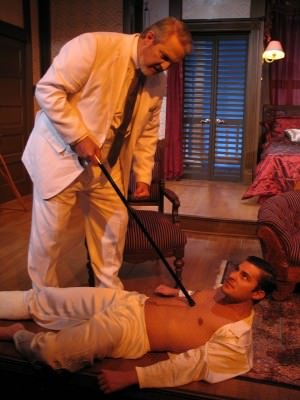Cat On A Hot Tin Roof
By Tennessee Williams
Directed by Jim Schneider
At Circle Theatre
“Mendacity is the system we live in,” Brick announces. ”Liquor is one way out and death’s the other.”
Gripping family saga still resonates today
Tennessee Williams 1955, Cat On A Hot Tin Roof, is a tough play to mount but director Jim Schneider’s Circle Theatre production mostly works despite several over-the-top performances. Many consider Cat as Williams’ finest work (I agree). Circle Theatre’s intimate space on Bob Knuth’s picturesque plantation bedroom set gave the show added intensity.

Set in the Delta country outside of Memphis in the 1950’s, we meet a rich family getting ready to celebrate Big Daddy’s (Jim Farrell in a subdued yet strong performance) 65th birthday. Maggie (Kimberly Logan) and Brick (Michael Borgmann) bicker about their marriage, Brick’s drinking and his inability (and lack of desire) to have sex with Maggie. Maggie gave several speeches that lay out her desires, her anxiety and her worries toward Brick and their place in the family as it appears that Big Daddy is terminally ill. Who will take over the plantation and manage the family wealth? Gooper (Justin Cagney) and his wife Mae (K.D. O’Hair) have five children while Maggie and Brick have none as the two siblings jockey for favor with Big Daddy. Big Mama (Deanna Norman) is in total denial as to Big Daddy’s health. Brick is the favorite son despite being childless and a drunk.

Williams finds classic tragedy in the contemporary South. In this poetic expressionist vision of the struggle between truth and illusion in the face of mortality and the fraught attempts of the family members to communicate amongst themselves, Williams deftly expresses the pain and loneliness each feels as they resort to attacking each other as their means of relating. Williams stated: “I am trying to catch the true quality of experience in a group of people, that cloudy, flickering, evanescent – fiercely charged! – interplay of live human beings in the thundercloud of a common crisis.” The physicality, especially between Maggie and Brick in act one and between Big Daddy and Brick in act three electrified the emotions and brutality of the family. Borgmann’s Brick’s, with a cast on his right foot and a never ending drink in hand, exuded a deep-seeded torment.

Kimberly Logan as Maggie (in the role that made Elizabeth Taylor a sex goddess in the film) nicely captured the rage, the sexuality and the sheer determination of the frustrated wife to the favored son (Brick). Michael Borgmann’s repressed homosexuality and self-hatred come across loud and clear. The talk scene with Big Daddy about why Brick drinks was intensely performed by Borgmann and Jim Farrell. That was the show’s best moments.
The play builds the dramatic tension gradually allowing each character to unwind their problems and interact effectively. The intensity of Big Mama could be toned down a tad and K.D. O’Hair’s screechy vocals were almost cartoonish. Maggie and Brick effectively portrayed the underlying anger and unfulfilled desires of their characters. Farrell’s Big Daddy, while commandingly intimating, still possessed a truthful need to help his son Brick battle his demons. The play demonstrates the destructiveness of repressed sexuality, alcoholism and repressed anger. It demonstrates how our inability to honestly communicate our feeling with one another that can lead to tragedy.
For the most part, the cast respected Williams’ work. The pacing was quick. The emotions built the dramatic arch into a several poignant moments. This Cat is worth seeing.
Recommended
Tom Williams
At Circle Theatre, 7300 W. Madison, Forest Park, IL, call 708-771-0700, Fridays & Saturdays at 8 pm, Sundays at 3 pm, running time is 3 hours with 2 intermissions, through October 4, 2009
